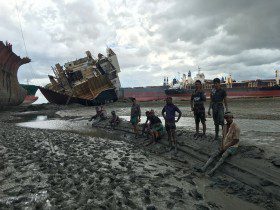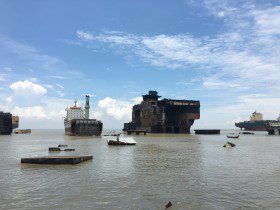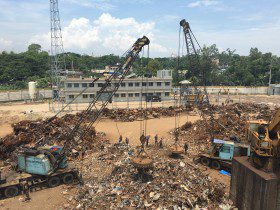This is part of a series in which we share reports from Harvard students who have traveled to South Asia with support from a SAI grant.
 By Marisa Houlahan, Harvard College ’17
By Marisa Houlahan, Harvard College ’17
With the support of the South Asia Institute, I spent the summer in Chittagong, Bangladesh, conducting ethnographic research for a senior thesis on the shipbreaking industry. Over the past decade, a confluence of geographic, historical, economic, geologic, and political factors has shaped South Asia, and Chittagong in particular, as the shipbreaking capital of the world. More than 70% of the world’s defunct merchant and passenger vessels are now dismantled in South Asia, where labor and environmental regulations are largely unenforced and shipbreaking yards do without the expensive infrastructure required to break ships in places like Japan, Korea, Europe, and the United States. The shipbreaking industry in Chittagong fills nearly half of the country’s growing demand for steel and provides thousands of jobs, however unstable. The industry is also responsible for the deaths of dozens of workers each year, who are victims of gas explosions, falling steel plates, and other accidents, and for leaching lead, asbestos, oil sludge, and other hazardous materials into the water, soil, and bodies of shipbreakers.
Since around 2005, the Chittagong shipbreaking industry has been a subject of intense fascination for foreign journalists, documentarians, artists, and reporters. Throughout the course of interviews, actors in the shipbreaking industry pointed to a myriad of potential causes for this foreign curiosity: the visual spectacle of massive ships run aground on the beach, exoticization of poverty and manual labor, generosity and a desire to alleviate suffering, implicit racism, and the attractively but deceptively simple narrative of the externalities of the developed world internalized in the developing world, a unidirectional movement which provokes pity, sympathy, distance, and moral indignation among the developed. Media attention and NGO involvement, both foreign and Bangladeshi, have gone hand in hand, and in the process have produced a set of frameworks through which the industry is frequently discussed. Newspaper articles might cast shipbreaking as a calculus between economic benefit and environmental degradation, or, most popularly, as a site of overwhelming death. Shipyards are described as “graveyards” or “hellish,” ships as “skeletal” or “end of life,” and even workers as perpetually near death.
 It was in the tangle of these intertwining narratives that I began my research in Bangladesh. I attempted to listen to the stories of people embedded in the industry, and from those stories begin to unearth the details that NGO reports, news articles, and adventure journalism tend to elide. Beyond that, I look to make claims about the situatedness of the Chittagong shipbreaking industry within a multinational system of legal regulations, the production of categories like “global” and “local,” and the inequities of transnational capitalism. I asked, what forces create Chittagong, and the bodies of local and migrant workers, as sites for shipbreaking and shipbreaking labor? How do legal regulations, aesthetic sensibilities, material demands, and the political economy of the shipbreaking industry create ships as ruins, waste, or commodities at the intersections between regimes of value? How might ships, largely conceived as wasted or ruinous, instead be both implicated in vibrant human and nonhuman networks and productive of new social and material worlds?
It was in the tangle of these intertwining narratives that I began my research in Bangladesh. I attempted to listen to the stories of people embedded in the industry, and from those stories begin to unearth the details that NGO reports, news articles, and adventure journalism tend to elide. Beyond that, I look to make claims about the situatedness of the Chittagong shipbreaking industry within a multinational system of legal regulations, the production of categories like “global” and “local,” and the inequities of transnational capitalism. I asked, what forces create Chittagong, and the bodies of local and migrant workers, as sites for shipbreaking and shipbreaking labor? How do legal regulations, aesthetic sensibilities, material demands, and the political economy of the shipbreaking industry create ships as ruins, waste, or commodities at the intersections between regimes of value? How might ships, largely conceived as wasted or ruinous, instead be both implicated in vibrant human and nonhuman networks and productive of new social and material worlds?
My fieldwork began by connecting with Young Power in Social Action (YPSA), a Chittagonian social development organization that has been fighting for the past decade to make the shipbreaking industry safer, to enforce the many regulations in place, and to hold ship owners and shipping companies accountable for the fate of their vessels. Through YPSA I researched the history of institutional and legal involvement in shipbreaking and studied the processes and assumptions that ground foreign media attention by shadowing the work of foreign photojournalists and news writers. Along the highway running parallel to the shipbreaking yards, I observed and interviewed at the scrap shops selling items from ships – everything from spoons and life jackets to compressors and generators – to families, distributors in Dhaka, and industrial clients. I also visited the steel mills tied to the industry, and conducted interviews with the vast global network of industry actors, including lawyers in London, shipbrokers in Singapore, antiques dealers in Boston and North Carolina, filmmakers in Dhaka, Germany, and Korea, and shipyard owners, activists, government officials, ship captains, bankers, buyers of ship products, middlemen, academics, and laborers in Chittagong.
 My methodological framework during my research was guided by anthropologist Anna Tsing’s ethnography of global connection developed in her book Friction, which pays close attention to the awkward encounters where aspiring universals like capitalism or commodity fetishism emerge in the particular and take on different meanings for different people, creating the productive friction of misunderstandings, partnerships, and unlikely connections. I come away from my fieldwork intrigued by an unexpected aspiring universal, which appeared over and over in interviews with everyone from international lawmakers to steel mill employees – waste. In Chittagong, I found that the easiest way to get laughed at was to ask a Bangladeshi, “So, what gets thrown away?” After chuckling indulgently at my naiveté, people usually told me that nothing gets wasted in Bangladesh; there is a use and a market for everything. This stands starkly at odds with shipbreaking legislation produced by the United Nations, which treats ships as floating pieces of waste, as well as with the practices of shipyards that claim, for the benefit of foreign visitors, to build hazardous waste storage facilities that are in fact empty rooms. Foreign and Bangladeshi NGOs rally around the damage done to the human and nonhuman environment by the waste products of broken ships, while scrap market owners and steel mills scoff at the idea of ships as waste in the first place when they are confronted every day with the task of turning ship into cash. Nor does the assertion that nothing gets wasted in Bangladesh always square with the things I saw – cracked porcelain sinks originally from ships and now strewn haphazardly on a highway median, food and household scraps encroaching on city streets, and what Zygmunt Bauman would controversially call the “wasted lives” of people excluded from the possibility of capitalist production.
My methodological framework during my research was guided by anthropologist Anna Tsing’s ethnography of global connection developed in her book Friction, which pays close attention to the awkward encounters where aspiring universals like capitalism or commodity fetishism emerge in the particular and take on different meanings for different people, creating the productive friction of misunderstandings, partnerships, and unlikely connections. I come away from my fieldwork intrigued by an unexpected aspiring universal, which appeared over and over in interviews with everyone from international lawmakers to steel mill employees – waste. In Chittagong, I found that the easiest way to get laughed at was to ask a Bangladeshi, “So, what gets thrown away?” After chuckling indulgently at my naiveté, people usually told me that nothing gets wasted in Bangladesh; there is a use and a market for everything. This stands starkly at odds with shipbreaking legislation produced by the United Nations, which treats ships as floating pieces of waste, as well as with the practices of shipyards that claim, for the benefit of foreign visitors, to build hazardous waste storage facilities that are in fact empty rooms. Foreign and Bangladeshi NGOs rally around the damage done to the human and nonhuman environment by the waste products of broken ships, while scrap market owners and steel mills scoff at the idea of ships as waste in the first place when they are confronted every day with the task of turning ship into cash. Nor does the assertion that nothing gets wasted in Bangladesh always square with the things I saw – cracked porcelain sinks originally from ships and now strewn haphazardly on a highway median, food and household scraps encroaching on city streets, and what Zygmunt Bauman would controversially call the “wasted lives” of people excluded from the possibility of capitalist production.
These ethnographic encounters lead me to wonder, what is waste? When is waste? How is waste managed, commodified, and contested? What assumptions and responsibilities, legal and moral, are variously seen to be attached to the narrative designation of waste? What regimes of value does waste connect or challenge? How is waste attached to or a conduit for power? I hope to address these questions, at least partially, as I continue down the rabbit hole of the Bangladeshi shipbreaking industry.
